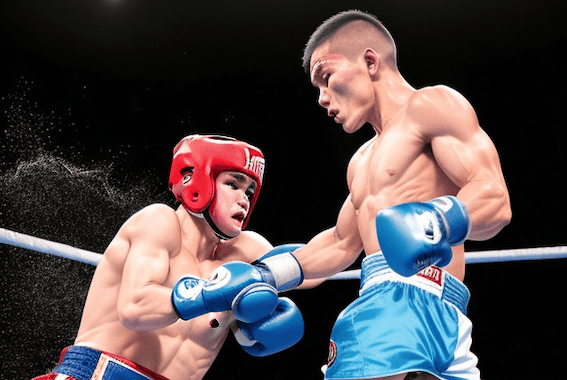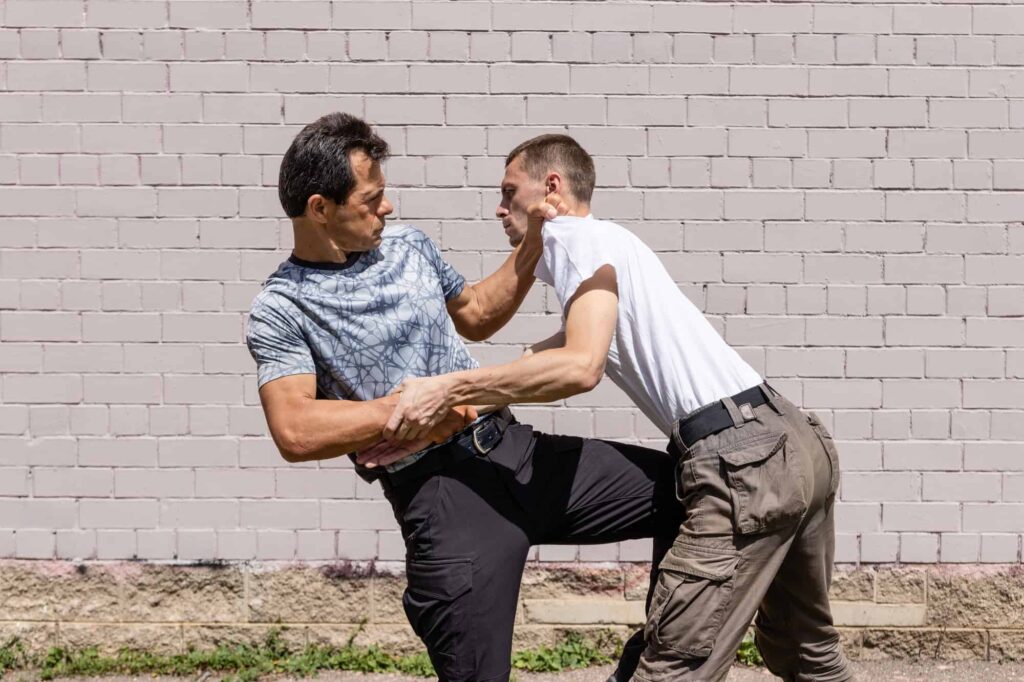When it comes to combat sports and their application in the real world the question of muay thai or boxing for self defense often comes up.
Among the myriad of martial arts and combat sports available, two disciplines, in particular, stand out for their storied histories and proven efficacy in self-defense scenarios: Muay Thai and Boxing.
Muay Thai, the “Art of Eight Limbs,” hailing from Thailand, and Boxing, the “Sweet Science,” originating in ancient Greece and popularized worldwide, have garnered a substantial following for their practicality and effectiveness in combat situations.
Both combat arts focus on striking techniques, but their training methods, philosophies, and tactics differ significantly.
In this article, we will delve into the distinct features of Muay Thai and Boxing and explore the nuances of each art when it comes to their application in real-world self-defense scenarios.

Boxing for Self Defense
Boxing offers several essential elements that make it highly useful in a self-defense situation.
While it may not encompass the full range of self-defense techniques, Boxing focuses on certain aspects that can be invaluable in real-world confrontations.
And these include:
Becoming Proficient in Striking
In most street altercations people resort to punches.
And boxing is all about avoiding and defending against punches while also developing powerful and accurate punching techniques.
By mastering the art of delivering punches with proper form and generating significant force, a boxer can effectively deter an attacked or end a fight due to becoming proficient in striking primarily with the hands.
Hand-Eye Coordination
Boxing training heavily relies on developing hand-eye coordination, quick reflexes, and spatial awareness.
These attributes that are developed through training boxing can be crucial in avoiding incoming attacks and responding with timely counters, enhancing the boxer’s ability to protect themselves effectively.

Footwork and Evasion
Boxing places a strong emphasis on footwork and head movement, enabling practitioners to dodge and evade incoming strikes.
Learning how to move efficiently and maintain distance can help boxers create space to escape dangerous situations or create opportunities to counter-attack.
Physical Conditioning
Boxing training involves rigorous cardiovascular workouts, endurance drills, and strength training, which not only improve physical fitness but also prepare individuals to handle the adrenaline and stress that accompanies a real-life self-defense situation.
Having the cardio and fitness to be able to run away from attackers is also a valuable strategy to have and requires a decent amount of physical conditioning.
Staying Calm Under Fire
Boxing places a lot of emphasis on sparring and this in turn develops the ability to stay ‘calm under fire’ when in the heat of battle.
The ability to remain calm, focused, and composed under pressure is invaluable in a self-defense encounter, where fear and panic can be paralyzing.
Muay Thai for Self Defense
Muay thai pretty much includes all of the same attributes that boxing develops when it comes to being useful for self defense.
Each of the attributes that boxing develops can be said to also be developed in Muay thai as those discussed above which are:
- striking proficiency (mainly delaing with punches which is the most common form of fighting techniques used in self defense and in the street)
- hand-eye coordination (also a major part of muay thai training)
- footwork and evasion( while boxing footwork is more focussed on evasion, muay thai also teaches to avoid attacks but with more emphasis on blocking and countering)
- physical conditioning (physical conditioning is a major part of muay thai and a very useful attribute to develop for self defense)
- staying calm under fire (sparring and the ability to use your techniques against a resisting opponetn is also a major part of muay thai training)
In addition to those discussed above, muay thai also has additional benefits when it comes to self defense – and these are not developed in boxing. They are:
More ‘Weapons’
As muay thai is the Art of 8 Limbs, muay thai trains to be proficient in use of legs for kicks, knees as well as elbows in addition to the hands or punches that boxing trains.
This is a very useful feature of muay thai for self defense as having more weapons in your arsenal so to speak is probably better when it comes to defending yourself.

Muay Thai Clinch
The muay thai clinch is the most developed form of stand up grappling and much emphais is trained on developing and perfecting the clinch in muay thai.
The clinch is very useful for negating an opponents attacks and putting them in vulnerable positions to reveive knees and elbows as well as being taken down with a number of sweeps, trips, dumps and throws that muay thai trains.
‘Teep’ – Front Kick
The teep is a particularly useful technique to have in self defense and can help one deter an attack or create distance to escape.
Nothing like the teep is included in any form of boxing.
Where boxing & Muay Thai Fall Short for Self Defense
While Boxing and Muay thai have numerous advantages in a self-defense context, they also have several limitations.
Ground fighting and grappling on the ground are not trained or considered at all in both boxing and muay thai.
When a fighter hits the ground in boxing or muay thai the referee will stand the fighters up to continue fighting or end the fight if a fighter can no longer continue.
And possesing the ability to escape pins, stranghles and chokes are useful skills to develop for self defense. But these are not considered in muay thai or boxing.
Defense against various weapons are areas where Boxing and muay thai also fall short in terms of self defense. And in self defense an attacker can either begin to attack with a weapon or pick an pbject up nearby and attack with that as a weapon.
Weapons attacks are a major area where both boxing and muay thai can be considered weak for self defense.

Also both boxing and muay thai do not train to deal with multiple attackers which is very common in self defense.
Both muay thai and boxing are fought under rules and regulations which include weight classes so this means the majority of the time, boxers and muay thai fighters fight against an opponent of around the same size and at least of the same weight.
And in self defense attackers may be much larger or smaller even.
This especially applies to females who most of the time are smaller than their attackers.
Consequently, a comprehensive self-defense strategy may involve combining Boxing and Muay thai with other martial arts or self-defense disciplines to address different types of threats effectively.
Which is Better? Muay Thai or boxing for Self Defense?
While both muay thai and boxing have many very useful and applicable techniques and strategies as well as attributes that can be applied effectively in self defense, it can be argued that muay thai posses more.
Mainly due to the use of more weapons i.e elbows, knees and kicks (front kick. low kick as well), this makes muay thai probably ‘better’ for self defense when looking at the range of techniques one can use effectively in self defense.
The muay thai clinch in particular is one area where muay thai can shine in a self defense situation over boxing.

At the end of the day a street fight or self defense situation can handled effectively with either boxing or muay thai.
A lot comes down to the individual themselves rather than their chosen style of combat art to train and learn.
And this has been shown over many years with many boxers and muay thai fighters using their skills in actual self defense situations to overcome attackers.


